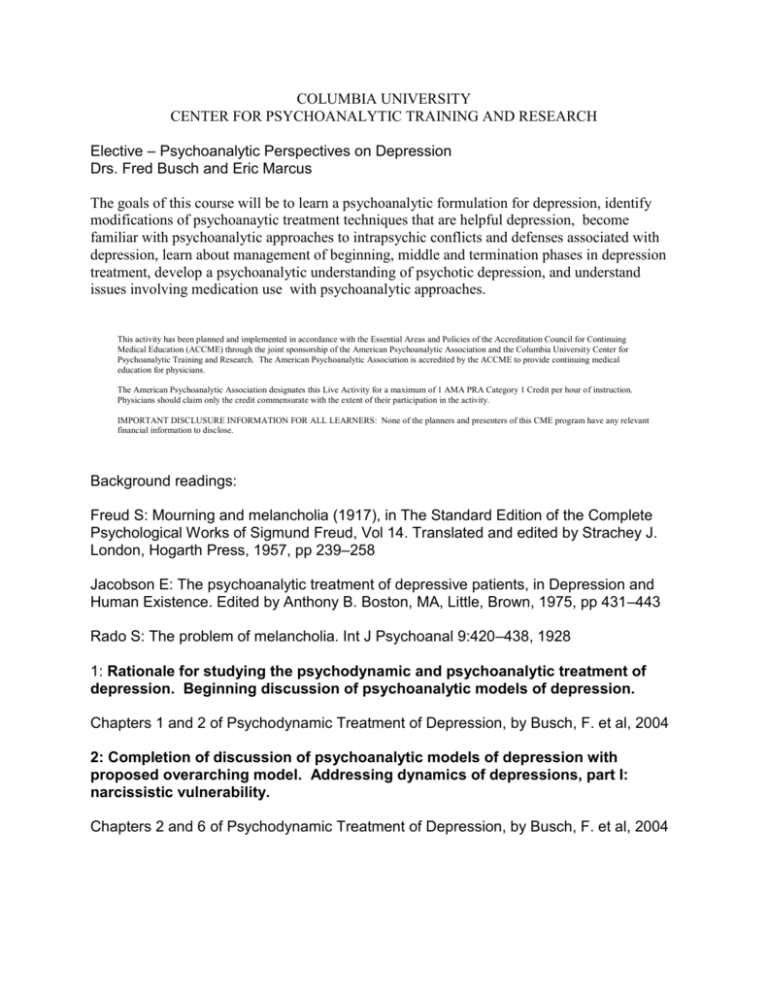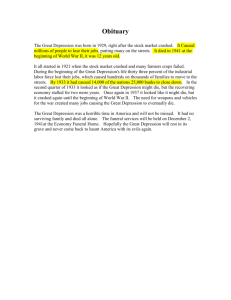COLUMBIA UNIVERSITY CENTER FOR PSYCHOANALYTIC
advertisement

COLUMBIA UNIVERSITY CENTER FOR PSYCHOANALYTIC TRAINING AND RESEARCH Elective – Psychoanalytic Perspectives on Depression Drs. Fred Busch and Eric Marcus The goals of this course will be to learn a psychoanalytic formulation for depression, identify modifications of psychoanaytic treatment techniques that are helpful depression, become familiar with psychoanalytic approaches to intrapsychic conflicts and defenses associated with depression, learn about management of beginning, middle and termination phases in depression treatment, develop a psychoanalytic understanding of psychotic depression, and understand issues involving medication use with psychoanalytic approaches. This activity has been planned and implemented in accordance with the Essential Areas and Policies of the Accreditation Council for Continuing Medical Education (ACCME) through the joint sponsorship of the American Psychoanalytic Association and the Columbia University Center for Psychoanalytic Training and Research. The American Psychoanalytic Association is accredited by the ACCME to provide continuing medical education for physicians. The American Psychoanalytic Association designates this Live Activity for a maximum of 1 AMA PRA Category 1 Credit per hour of instruction. Physicians should claim only the credit commensurate with the extent of their participation in the activity. IMPORTANT DISCLUSURE INFORMATION FOR ALL LEARNERS: None of the planners and presenters of this CME program have any relevant financial information to disclose. Background readings: Freud S: Mourning and melancholia (1917), in The Standard Edition of the Complete Psychological Works of Sigmund Freud, Vol 14. Translated and edited by Strachey J. London, Hogarth Press, 1957, pp 239–258 Jacobson E: The psychoanalytic treatment of depressive patients, in Depression and Human Existence. Edited by Anthony B. Boston, MA, Little, Brown, 1975, pp 431–443 Rado S: The problem of melancholia. Int J Psychoanal 9:420–438, 1928 1: Rationale for studying the psychodynamic and psychoanalytic treatment of depression. Beginning discussion of psychoanalytic models of depression. Chapters 1 and 2 of Psychodynamic Treatment of Depression, by Busch, F. et al, 2004 2: Completion of discussion of psychoanalytic models of depression with proposed overarching model. Addressing dynamics of depressions, part I: narcissistic vulnerability. Chapters 2 and 6 of Psychodynamic Treatment of Depression, by Busch, F. et al, 2004 3) Addressing dynamics of depression, part II: angry reactions to narcissistic injury and the severe superego. Chapters 7 and 8 of Psychodynamic Treatment of Depression, by Busch, F. et al, 2004 4) Addressing dynamics of depression, part III: idealization and devaluation, defense mechanisms. Chapters 9 and 10 of Psychodynamic Treatment of Depression, by Busch, F. et al, 2004 5) Addressing transference and countertransference, characterological factors in depression, analytic vs. dynamic treatment. Chapter 5 of Psychodynamic Treatment of Depression, by Busch, F. et al, 2004 Marcus ER. Integrating psychopharmacotherapy, psychotherapy, and mental structure in the treatment of patients with personality disorders and depression. Psychiatr Clin North Am. 1990 Jun;13(2):255-63. Review. 6) Understanding and treatment of near psychosis and psychotic depression. Marcus ER (2003). Near psychotic structure, chapter 3 in Psychosis and near psychosis: ego function, symbol structure, treatment. Springer. 7) Analytic approaches and psychopharmacology. Chapter 14 of Psychodynamic Treatment of Depression, by Busch, F. et al, 2004 chapter 8 in Psychotherapy and Medication., by F. Busch and L. Sandberg, 2008, pps 119-128 only 8) Difficult cases and suicidality. Chapters 12 and 13 in of Psychodynamic Treatment of Depression, by Busch, F. et al, 2004






